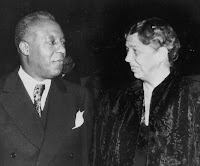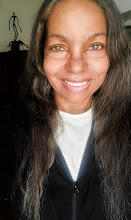A. Philip Randolph got black pilots trained for World War II combat in the Tuskegee Airmen program during the era of Jim Crow laws.
 |
| A. Philip Randolph Eleanor Roosevelt |
A. Philip Randolph was labeled the most dangerous black man in America because of his ability to organize people around a cause like the Tuskegee Airmen. If anyone could pull off black pilots in the U.S. military, it would be A. Philip Randolph and his partner in the venture, First Lady Eleanor Roosevelt, who was known to influence her husband, Franklin Roosevelt in matters of race and human rights.
Born in 1889 in Florida just at the beginning of the official Jim Crow era, Randolph by his teen years was already heavily involved in civil rights, using his voice and speaking abilities learned as an actor and singer. As a journalist and founder of a magazine, Randolph honed the skills he needed to become a leader for social causes.
An articulate and persuasive personality and speaker with experience in leadership, he organized the Brotherhood of Sleeping Car Porters in 1925. Black men who held railway porter jobs were considered well employed during the era of Jim Crow laws. However, Randolph saw these jobs as incomplete with a union to protect them. After organizing the union, he served as President of the Brotherhood of Sleeping Car Porters from 1929 until 1968. These impressive credentials gave him the clout to appeal to Eleanor Roosevelt for assistance in getting his black pilots program off the ground as well as other causes dealing with unfair jobs and military contract accessibility to people of color.
A. Philip Randolph burst onto the scene before Martin Luther King and furnished fuel for the establishment of the Tuskegee Airmen.
An articulate and persuasive personality and speaker with experience in leadership, he organized the Brotherhood of Sleeping Car Porters in 1925. Black men who held railway porter jobs were considered well employed during the era of Jim Crow laws. However, Randolph saw these jobs as incomplete with a union to protect them. After organizing the union, he served as President of the Brotherhood of Sleeping Car Porters from 1929 until 1968. These impressive credentials gave him the clout to appeal to Eleanor Roosevelt for assistance in getting his black pilots program off the ground as well as other causes dealing with unfair jobs and military contract accessibility to people of color.
Men like my own father and uncles served in this army during WWII and were not allowed out of the military kitchens and, in some cases, not allowed to handle real weapons, only mock guns that were not intended to shoot real bullets. My father had sour feelings about the way the Army treated him, especially before the forces left the United States. In southern training facilities, servicemen were not allowed to go into towns during their time off in fear of the local community that these black servicemen would come into contact with the community's white women. "There was a white army and a black army," my said. "The one had the duty of serving the other, no different than it was in jobs here at home."
 |
| Maycie Herrington Tuskegee Airmen Historian |
A. Philip Randolph proposed a March on Washington before Martin Luther King.
Randolph's threatened March on Washington and other civil rights activities helped in the establishment of the African American fighter pilots program as part of the Army Air Force at a segregated base located in Tuskegee, Alabama that would train the Tuskegee Airman.
Maycie Herrington began chronicling the history of the Tuskegee Airmen when she was a civilian clerk at the U.S. Army Air Base during the WWII training of America's first black pilots. This was during the days of Jim Crow laws when African American pilot training had been prohibited. the Tuskegee black pilot training, which began as an experiment, promoted by A. Philip Randolph, changed the course of WWII and the course of United States civil rights history.
Hundreds of black pilots were trained at Tuskegee to see action in WWII. Maycie Herrington collected stories, photographs and documents, which she has shared with the world ever since.
In Tuskegee Airmen History, Macy Herrington wrote her account of the Tuskegee Airmen, published by the Tuskegee Airmen, Los Angeles Chapter. Herrington was part of the civilian support staff at Tuskegee when the black pilots were in training and has spent most of her adult life documenting the WWII project.
Tuskegee Airmen, Jim Crow Laws and Black Pilots
Maycie Herrington's biography is included in BREAKING THROUGH Lighting the Way, profiles of African American Women who made a difference to the history of Long Beach, California.
 |
| Maycie Herrington Tuskegee Institute WWII |
A. Philip Randolph and and his struggle to get the Tuskegee Airmen set the stage for Rosa Parks and Martin Luther King's Montgomery Bus Boycott and the Woolworth Sit-ins.
Maycie Herrington said, “A. Philip Randolph included a demand for the immediate designation of centers where Negroes would be trained for work in all branches of the aviation corp. He said it was not enough to only train (black) pilots. In addition, navigators, bombardiers, gunners, radiomen and mechanics must be trained in order to facilitate full Negro participation in the air service.
A. Philip Randolph was a civil rights leader of the mid-20th century, beginning in the 1920-30s. He is credited for shaping, the guide that was used in the 1950s-60s by the Martin Luther King to shape his I Have A Dream message. This monumental book about Randolph by Cornelius Bynum covers his protest career, from the organization of Brotherhood of Sleeping Car Porters, a black rail union, to threatening a march on Washington as early as 1941.

No comments:
Post a Comment
Note: Only a member of this blog may post a comment.